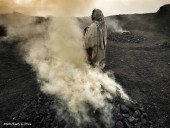Press Release
PDF Download
Download the Press Release PDF
Online Text Version
NEW REPORT IS FIRST TO QUANTIFY HEALTH IMPACTS FROM
WORLD’S WORST TOXIC POLLUTION PROBLEMS
Report Identifies Top Pollution Problems and Sources, and Reveals Surprising Finding About Corporations and Pollution
New York, NY--November 9, 2011--A new report released today by New York-based Blacksmith Institute and Green Cross Switzerland identifies the top ten toxic pollution problems and sources. The report also calculates, for the first time, the health impacts of toxic sites. The calculations show that people impacted by the polluted sites analyzed in the report could lose an average of 12.7 years to death or disability. This measurement is called Disability-Adjusted Life Year or DALY, and represents the sum of life years lost and years lived with disability. The report also reveals that, contrary to popular belief, most toxic hotspots result from poorly regulated, locally owned small- and medium-scale operations, rather than large multinational corporations. The report offers the most targeted picture of pollution’s toll to date, and is a crucial step in prioritizing life-saving cleanup efforts
The World’s Worst Toxic Pollution Problems 2011 report is the latest in a series of annual reports documenting global pollution issues. Since 2006, Blacksmith's yearly reports have been instrumental in increasing public understanding of the health impacts posed by toxic pollution, and in some cases, have compelled cleanup work at pollution hotspots. Blacksmith reports have been issued jointly with Green Cross Switzerland since 2007. The 2011 report, as well as all previous reports, are available online at www.worstpolluted.org.
“This report shows pollution’s toll in real quantifiable numbers, allowing us to identify which sites have the most at-risk populations and which pollution problems and toxins cause the most damage,” says Richard Fuller, president, Blacksmith Institute. “Using the same methodology, we intend to calculate health impacts for all the polluted sites and problems in our database so that can prioritize our cleanup efforts in order to save the most lives.”
Targeted Research: The 2011 report uses data collected by Blacksmith Institute over the past three years during site assessments at thousands of toxic hotspots in low- and middle-income countries. Drawing from this body of research, the report is able to isolate and identify the most severe and widespread pollution problems and directly link them to human health impacts. The report offers information needed to solve this global problem site-by-site, industry-by-industry.
Death and Disability Calculations: The key to this report is that it calculates the impact of pollution in terms of years of life lost and years spent in poor health, whereas much of the current research in environmental health focuses only on deaths. Because toxic pollution often leads to crippling disability that does not always result in death, many victims are left uncounted by basic mortality statistics. The sum of life years lost and years lived with disability is called a Disability-Adjusted Life Year or DALY. The DALY offers a clearer picture of pollution’s toll. For example, the World Health Organization has estimated that globally, toxic chemical exposure was responsible for 4.9
million deaths and 86 million DALYs in 2004. This latter figure suggests that many millions of people live with disabilities caused by exposure to toxic chemicals.
Majority of Hotspots Result from Small, Local Operations: Another key finding of the report is that many of the worst pollution problems stem not from multi-national companies, but from poorly regulated small-scale operations like artisanal mining, backyard metal recycling, and outdated or abandoned factories. This does not mean that high-income countries are not contributing significantly to the problem. Demand for commodities and consumer goods, driven largely by the economies of high-income countries, results in many of these smaller industries, adding to the severity of pollution problems in low-income countries.
Top Toxic Pollution Problems:
- Mercury from Artisanal Gold Mining
- Lead from Industrial Estates
- Pesticides from Agricultural Production
- Lead from Lead Smelting
- Chromium from Tanneries
- Mercury from Mining and Ore Processing
- Lead from Mining and Ore Processing
- Lead from Lead-Acid Battery Recycling
- Arsenic from Naturally Occurring Sources
- Pesticides from Pesticide Production and Storage
Top Toxic Pollution Sources:
- Mining and Ore Processing
- Metal Smelting
- Chemical Manufacturing
- Artisanal & Small-Scale Mining
- Mixed Industrial Estates
- Agricultural Production
- Industrial /Municipal Waste Disposal
- Heavy Industry (metal casting, rolling, stamping)
- Petrochemical Industries
- Tanneries
EDITORS: Interviews are available
About Blacksmith Institute, www.blacksmithinstitute.org
Blacksmith Institute is an international not-for-profit organization dedicated to solving life-threatening pollution issues in the developing world. Based in New York, Blacksmith works cooperatively in partnerships that include governments, the international community, NGOs and local agencies to design and implement innovative, low-cost solutions to save lives. Since 1999, Blacksmith has completed over 50 cleanup projects in 21 countries.
About Green Cross Switzerland, www.greencross.ch/en/
Green Cross Switzerland facilitates overcoming consequential damages caused by industrial and military disasters and the clean-up of contaminated sites from the period of the Cold War. Central issues are the improvement of the living quality of people affected by chemical, radioactive and other types of contamination, as well as the promotion of a sustainable development in the spirit of co-operation instead of confrontation.
Blacksmith Institute
2014 Fifth Avenue. New York, NY 10035 USA
Phone: (212) 647 8330
Fax: +1 (212) 647 8334
Email:
Media Inquiries
Media inquiries should be directed to Magdalene Sim
at: +1 (212) 647 8330
Media inquiries in Europe should be directed to Nathalie Gysi at:
##





